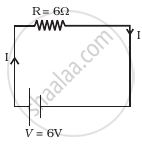Advertisements
Advertisements
प्रश्न
On the basis of electron drift, derive an expression for resistivity of a conductor in terms of number density of free electrons and relaxation time. On what factors does resistivity of a conductor depend?
उत्तर
Free electrons are in continuous random motion. They undergo change in direction at each collision and the thermal velocities are randomly distributed in all directions.
∴ Average thermal velocity
`u=(u_1+u_2...u_n)/n = 0 `

The electric field E exerts an electrostatic force ‘−Ee’
The acceleration of each electron is
`veca=(-evecE)/m `
Here,
m → Mass of an electron
e → Charge on an electron
Drift velocity is given by
`vecv_d=(v_1+v_2+....+v_n)/n`
`vec(V_d)=((vecu_1+vecat_1)+(vecu_2+vecat_2)+...+(vecu_n_vecat_n))/n`
Here,
`vecu_1,vecu_2->` Thermal velocities of the electrons
`vecatau_1,vectau_2` Velocities acquired by electrons
τ1, τ2 → Time elapsed after the collision
`vecv_d=(vecu_1+vecu_2+...vecu_n)/n+(veca(t_1+t_2+...t_n))/n`
Since`(vecu_1+vecu_2+...+u_n)/n=0`
∴ vd = a τ .....(3)
Here `t=(t_1+t_2+t_3...+t_n)/n` is the average time elapsed.
Substituting for a from equation (2),
`vec(V_d)=(-evecE)/mt...(4)`
Because of the external electric field, electrons are accelerated. They move from one place to another and current is produced.
For small intervals dt, we have
Idt = −q
Here, q is the total c
(i) The average velocity of all the free electrons in the conductor with which they get drifted towards the positive end of the conductor under the influence of an external electric field is called the drift velocity.
(ii) Free electrons are in continuous random motion. They undergo a change in direction at each collision and the thermal velocities are randomly distributed in all directions.
∴ Average thermal velocity
`u=(u_1+u_2...u_n)/n = 0 `

The electric field E exerts an electrostatic force ‘−Ee’
The acceleration of each electron is
`veca=(-evecE)/m `
Here,
m → Mass of an electron
e → Charge on an electron
Drift velocity is given by
`vecv_d=(v_1+v_2+....+v_n)/n`
`vec(V_d)=((vecu_1+vecat_1)+(vecu_2+vecat_2)+...+(vecu_n_vecat_n))/n`
Here,
`vecu_1,vecu_2->` Thermal velocities of the electrons
`vecatau_1,vecatau_2->` Velocities acquired by electrons
τ1, τ2 → Time elapsed after the collision
`vecv_d=(vecu_1+vecu_2+...vecu_n)/n+(veca(t_1+t_2+...t_n))/n`
Since`(vecu_1+vecu_2+...+u_n)/n=0`
∴ vd = a τ .....(3)
Here `t=(t_1+t_2+t_3...+t_n)/n`is the average time elapsed.
Substituting for a from equation (2),
`vec(V_d)=(-evecE)/mt...(4)`
Because of the external electric field, electrons are accelerated. They move from one place to another and current is produced.
For small intervals dt, we have
Idt = −q
Here, q is the total charge flowing.
Let n be the free electrons per unit area. Then, the total charge crossing area A in time dt is given by
Idt = neAvddt
Substituting the value of vd, we obtain
`Idt= n eA(-eE/m) dt`
I/A = J
Here, J is the current density.
`|J|=n e^2/m |E|T`
From Ohm’s law,
J = σE
Here, σ is the conductivity of the material through which the current is flowing.
Thus,
`sigma =(n e^2)/mT`
`sigma=1/rho`
or
`rho=1/sigma`
Substituting the value of conductivity, we obtain
`rho=m/(n e^2T)`
Here, τ is the relaxation time.
संबंधित प्रश्न
Estimate the average drift speed of conduction electrons in a copper wire of cross-sectional area 2.5 × 10−7 m2 carrying a current of 1.8 A. Assume the density of conduction electrons to be 9 × 1028 m−3.
Electrons are emitted by a hot filament and are accelerated by an electric field, as shown in the figure. The two stops at the left ensure that the electron beam has a uniform cross-section.

The position-time relation of a particle moving along the x-axis is given by x = a - bt + ct2 where a, band c are positive numbers. The velocity-time graph of the particle is ______.
At room temperature, copper has free electron density of 8.4 × 1028 per m3. The copper conductor has a cross-section of l0−6 m2 and carries a current of 5.4 A. The electron drift velocity in copper is:
The relaxation time τ is nearly independent of applied E field whereas it changes significantly with temperature T. First fact is (in part) responsible for Ohm’s law whereas the second fact leads to variation of ρ with temperature. Elaborate why?
- Consider circuit in figure. How much energy is absorbed by electrons from the initial state of no current (ignore thermal motion) to the state of drift velocity?
- Electrons give up energy at the rate of RI2 per second to the thermal energy. What time scale would one associate with energy in problem (a)? n = no of electron/volume = 1029/m3, length of circuit = 10 cm, cross-section = A = (1mm)2

Explain how free electrons in a metal at constant temperature attain an average velocity under the action of an electric field. Hence, obtain an expression for it.
A potential difference (V) is applied across a conductor of length 'L' and cross-sectional area 'A'.
How will the drift velocity of electrons and the current density be affected if another identical conductor of the same material were connected in series with the first conductor? Justify your answers.
Two conductors, made of the same material have equal lengths but different cross-sectional areas A1 and A2 (A1 > A2). They are connected in parallel across a cell. Show that the drift velocities of electrons in two conductors are equal.
The drift velocity of electrons in a conductor connected to a battery is given by vd = `(−"eE" τ)/"m"`. Here, e is the charge of the electron, E is the electric field, τ is the average time between collisions and m is the mass of the electron.
Based on this, answer the following:
- How does the drift velocity change with a change in the potential difference across the conductor?
- A copper wire of length 'l' is connected to a source. If the copper wire is replaced by another copper wire of the same area of cross-section but of length '4l', how will the drift velocity change? Explain your answer.
